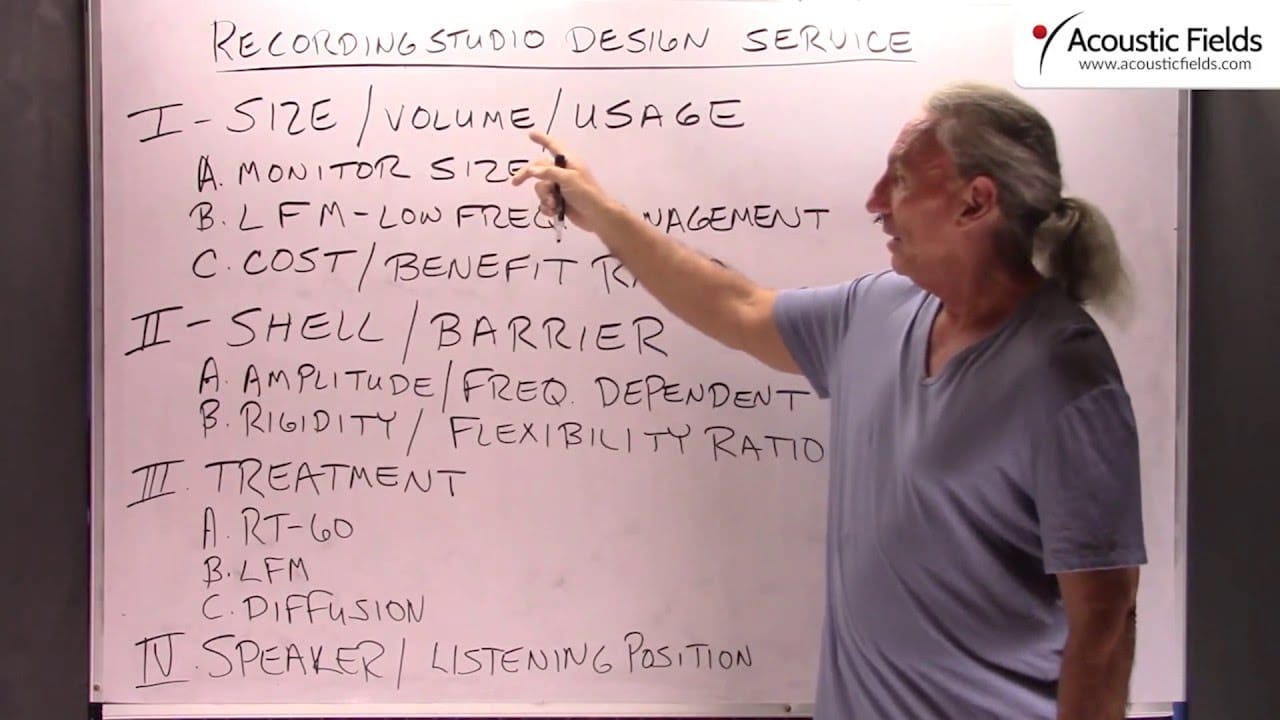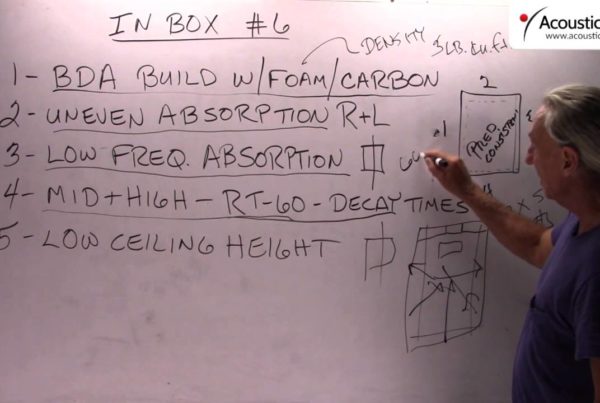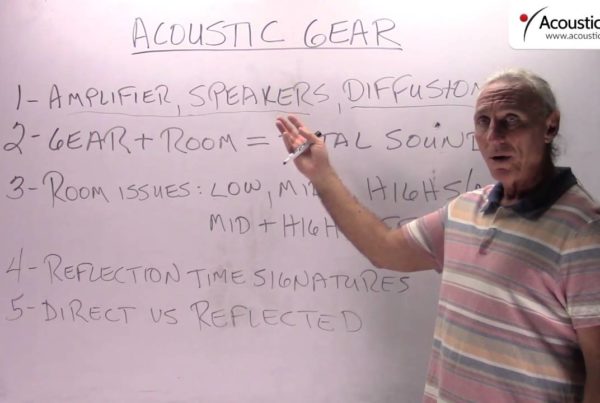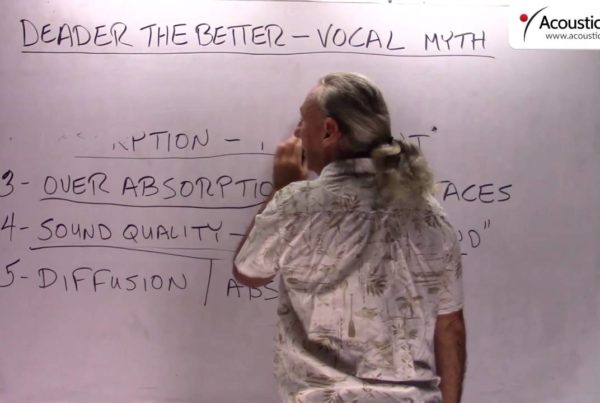Today we’re going to talk about recording studio design and services that we provide for recording studio design. I’ll kind of walk you through the main points, how we look at a room, how we approach the project so you get a feel for how we think and how we do things.
The first thing that you have to consider and everybody struggles with this is size, volume and usage. You must choose the right sized room, you must have the right volume for what you’re trying to do. So we’re trying to do recording studio design so if it’s a control room, live room, vocal room; it doesn’t matter what the usage is. There’s a particular volume and there’s a particular size that we have to be careful with.
And why do we need that? Because our monitor size that we’re going to be working with is directly dependent on the room volume. Why? Because the low frequency management issues that you have to do inside the room – if our volume and size are not the right ratios – can get very expensive. Low frequency management takes up space and costs a lot of money. Two things that we really don’t want to do today the way things go. So you always have to look at the cost benefit ratio.
If we’re forced to have a smaller size and less volume for our particular usage, it might be better looking at the cost and the benefit of everything, that low frequency management cost and all that to find a bigger room. A lot of money saved in the long run and better sound produced also.
The shell or the barrier. We have two parts to our recording studio design. We have the shell and then we have the interior room treatment. The shell or the barrier is completely amplitude and frequency dependent on the noise. We know that if we have a barrier, if we have noise here, okay? And this is our control room here where we’re sitting. That the noise source and the barrier are directly dependent.
So how big this is or the amplitude, the strength and the frequency of the noise is directly related to the barrier that we use. What layers of material we use, what’s their density, what’s their mass, how thick and what is this? This is all cost.
So if we measure our amplitude frequency of noise on the outside, that directly tells us how to build the particular barrier. A common construction – stubble, dry wall, air space in the middle. Not effective. Not effective below 125 cycles. Low frequency energy runs right through it. This guy the other day built his home theater room that way and he wasn’t happy. He said I’m not happy, I said why are you calling me? You built it the way it was supposed to be built, right? And he said no, I get too much bleed of low frequency energy into the other room so my family is not happy.
So you have to be careful. So the barrier is directly dependent on the amplitude of the noise. You can’t guess here. Well, I think we’ll just do this. Every time I hear that I freak. Because if you guess in acoustics, you’ll always guess wrong. Especially with barrier technology.
So the shell or the barrier is amplitude frequency dependent and definitely cost. Because every layer of material we have to add costs labor and material. So we have to be aware of that.
There also needs to be a rigidity flexibility ratio between the shell of our building and the interior part. So if our exterior wall surface is concrete, that’s very rigid. Very dense, it doesn’t move very much.
So our interior wall structure then has to give a little bit. There’s various techniques that we use to keep this rigidity, flexibility ratio in tune with good quality sound on the inside. So depending on the barrier that you have – most people aren’t fortunate enough to have concrete, they have a frame, so then we use a little bit different approach on the room treatment.
So everything is related, everything is working together, everything is married together, everything has to get along.
Okay, so the inside of our room is the treatment side. What do we have inside the room? Well, we have obviously all the reflections off all the surfaces, that has to be dealt with – and the summation of all those reflections is our RT-60 time. So we have to treat that. Not that difficult, okay? Compared to building a barrier, much, much simpler.
Here is the issue, the low frequency management. If you chose the right size and you have the right volume for the particular usage, then you should have less low frequency management to deal with. And that’s a good thing because low frequency management like we said before, is expensive. So you want to make sure you choose the right size and volume so that your low frequency management doesn’t take up a lot of space and does the job that you need.
Just to give you an idea, with our carbon technology which is the most powerful technology in the world to date, we need at least 12 inches of space to impact a change down in the 30 cycles. So if you don’t have the right size and volume of the room, and you’ve got to give up 12 inches of space all the way around the room, you can see the impact that has on cost and everything else. So you have to be really careful and study all this stuff ahead of time.
Diffusion is also another popular technology for recording studio design. In vocal rooms we use it all the time. The rear wall of control rooms, very, very popular, one dimensional, not two. So you have to plan for that. And that’s all dependent on speaker and listening position. How far away you are from the monitors, how far away from the rear wall and all those other issues that you have to address.
So room size, volume, match it to your usage. The shell or the barrier, we’ve got to match it to the amount of noise, and our barrier’s directly dependent on those measurements. No guessing. If you build something and you’ve guessed and you’ve guessed wrong, you’re in trouble. It’ll cost you more to fix a problem, a bad guess than it will be to do some measurements and get it right in the beginning. And measuring noise is not that difficult.
So and then the treatment on the inside. Reflections, low frequency and diffusion. Those are your three issues and positioning the speaker and the listening position, monitoring position in the case of a control room, in the right spot to get the smoothest frequency response in the room, it’s critical.
So I hope that helps you a little bit with the recording studio design services that we provide, just let us know how we can help you.
—
This is an unedited transcript from our video series from Acoustic Fields. There will be some errors in grammar and sentence structure that occur during this translation process.
For complete understanding and comprehension, please view the video which is included in this text. For any additional information regarding this topic or others relating to room acoustics, please contact us directly at:
P: 520 – 392 – 9486







